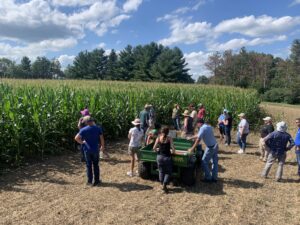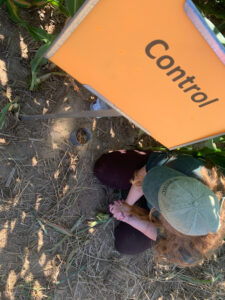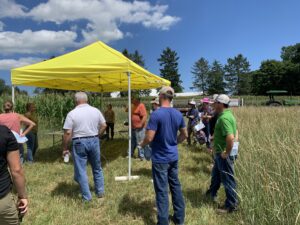Final report for FNC21-1308
Project Information
Jim Stute operates Stute Farms in Walworth County, located on the edge of the Kettle Moraine in Southeast Wisconsin. The farm is roughly 160 acres and the operation consists of owned and leased land, all treated identically. Soils are primarily Fox silt loams, common to the region, which are lighter textured, rolling, have limited moisture holding capacity and are erosion prone. The farm is in the Mukwonago River Watershed, classified as an exceptional water resource by the Wisconsin Department of Natural Resources. The farm is in an area of high ground water recharge-defined and delineated by WDNR and included in the 2010 Walworth County Land and Water Resource Management Plan (Walworth County LURM, 2010). This area is critical for prevention of soluble nutrient leaching (including nitrate and sulphate) to protect baseflow of the Mukwonago River.
Current crop production includes corn, soybean and occasionally wheat, all no-till. Additional conservation practices include cover crops, use of certified nutrient management planning, in-season diagnostic tests, integrated pest management and subsurface application of nutrients. An example of diagnostic testing is the 2021 use of the preplant soil nitrate test to account for residual nitrate-nitrogen resulting from an extremely dry 2020 growing season. The farm has been in continuous no-till since 2003 and cover cropped since 1994.
No-till improves sustainability by protecting the resource base. Many of the fragile soils in Southeast Wisconsin which could benefit most from no-till are also prone to surface crusting which can result in delayed or uneven emergence and reduced stands which reduce yield and farmer income. Users of conventional tillage cite this as a reason not to no-till, increasing erosion and surface water quality declines. Application of gypsum has been suggested as a solution which can also supply sulfur as a nutrient but commercial application rates far exceed rates needed for soil structural and nutrient benefits and supplies of flue gas desulfurization gypsum are dwindling as coal-fired power plants are closed, increasing price. Can low rates band-applied at planting address this problem?
A 2-year replicated field study was conducted to evaluate the effect of gypsum applied at planting on stand establishment, sulfur nutrition and yield of corn and soybean. Gypsum was applied through standard planter insecticide application attachments at maximum and one-half maximum rates and compared to a no gypsum and unlimited sulfur controls. Results and experiences were shared through a dedicated field day, interactions with regional farmer-led watershed protection groups and in print materials.
- Determine if in-row band application of gypsum at planting can improve emergence and stand uniformity in corn and soybean;
- Determine the effect of gypsum application on crop yield;
- Evaluate the impact on sulfur fertility to modify current practices if necessary; and
- Share results with the agricultural community, focusing on farmer-led watershed protection groups.
Research
Two, two-year field studies to investigate the impact of row-applied gypsum on crop emergence and yield were conducted near East Troy, WI 2021-22 in both corn (GYPC) and soybean (GYPSb). These trials represent both phases of the farms base annual rotation and were intended to follow the rotation (i.e., opposite previous crop) in both studies. In 2021 a rainout during planting of GYPC forced trial relocation and necessitated corn following corn, a practice not used on the farm. Trials were conducted in rotation in 2022.
The soil is a Fox silt loam, 0-2% slope, and has been in continuous no-till since 2003, a corn-soybean rotation since 2013 and has not had a cover crop since 2010. The change of long-term field histories from the annual report is due to the addition of two new fields in 2022. Beyond the treatments applied, the trials followed the farms routine practices for crop culture, pest management and soil fertility except for starter fertilizer, whose rate of was reduced to 33% of routine to minimize interactions with treatments yet provide a “starter” effect. A summary of site conditions, field activities and inputs are reported in Table 1.
Trial treatments include:
1). Control, no gypsum
2). Gypsum, half rate
3). Gypsum, full rate
4). No Gypsum, sulfur unlimited
Gypsum was applied in a T-band at planting using standard insecticide boxes on the planter [Kinze row units, 70 lb. capacity hopper, 10 paddle gate meter (Figure 1), 7” diffuser width]. Before planting, we compared different gypsum forms (pelletized, coarse and powder) to determine consistency of material flow and delivery rate and chose a commercial pelletized product (NutraSoft OP, The Andersons Inc., Maumee, OH 43537). Individual row units were calibrated for a uniform maximum rate, then a one-half maximum rate, based on planter transmission speeds for target crop seeding rates. Application rates are listed in Table 1. It should be noted that soybean seeding rate was increased to result in an acceptable range of gypsum application rates in 2021. A change in planting equipment in 2022 allowed using near identical application rates while delivering the farms routine seeding rate for soybean.
The 4th treatment is included to provide a sulfur control in the event yield differences to treatment occur to help separate the material effect on soil physical properties from nutrient effects. Pelletized sulfur bentonite (0-0-0-90, Tiger 90CR, Tiger-Sul Products LLC, Shelton, CT 06484) was band applied between crop rows immediately after planting at a sulfur rate equivalent of 50 lb./acre, 2x the maximum recommended by UW-Extension (Laboski and Peters, 2012). Soil S was determined before planting (Table 1) and tissue sampled and analyzed for nutrient content following UW- Extension Recommendations.
Other than treatment differences, plots were treated identically, following the cultural practices of the farm. Emergence data and observations were collected daily through the emergence period with special emphasis on uniformity and population. An assessment of final stand and delayed emergence as indicated by the presence of “peepers”, late emerging corn plants which are developmentally delayed and have minimal potential to contribute to yield was made thirty days after first emergence (30DAE). The degree of surface crusting was concurrently characterized using air-dry rupture measured using a Torvane shear vane penetrometer to measure the force required to break the crust. Final population was determined at mechanical harvest. Planned infiltration rate measurement was not performed because of the failure to install the apparatus immediately after planting (subsequent installation could potentially affect soil crust and influence results).
The experimental design is a randomized complete block with 4 replicates. Final plot size is 10 (4 row) by 50 feet. All data was collected from the center two rows to minimize border effects. Both crops were mechanically harvested with a 2-row plot combine. Data were subject to analysis of variance procedures using RStudio (ver. 2021.09.1) and means separated with a protected LSD (p=0.10) where significant treatment effects were detected. Emergence and related variables were analyzed using a subset of treatments (1-3) to directly evaluate the impact of gypsum because they relate to soil physical condition. Analysis of tissue nutrient and yield variables included all treatments. Data are presented in combined form and by year because several variables indicated a tendency for treatment interactions with growing season conditions. The Cor procedure was used to characterize the relationship between tissue S and grain yield in 2021.
Gypsum had no demonstrated impact on emergence or stand but variably influenced corn S fertility and grain yield under come conditions while having no effect on measured variables in soybean.
Growing seasons
The 2021 and 2021 seasons offered stark contrasts except for a common, prolonged dry period in mid-season and a lack of individual precipitation events from planting through 30 days post-emergence which could induce crust formation (Table 1). 2021 was a drought year with cumulative monthly precipitation deficits and a season total precipitation 46.2% of normal, impacting yield. Temperatures were also above normal, resulting in growing degree day (GDD) accumulation 110.5% of normal. Total 2022 precipitation was near normal but unevenly distributed and cycled between wet early and late with dry a mid-season resulting in crop moisture stress. Abundant precipitation from late July onward helped crops recover resulting in typical soybean and above average corn yields. The contrasting impact of years on crop variables can be seen in Table 2, Table 3 by comparing trial means.
Crop emergence and stand establishment
In the absence of rain events which would promote crusting, gypsum had no impact emergence variables in either crop. In corn, with a complete set of measurements, it’s evident that corn emerged rapidly and uniformly in 2021, and while uniform between treatments in 2022, full emergence and stand establishment took longer (Table 2). 2022 also had a tendency towards more peepers as a percent of the final stand indicating uneven emergence but treatments had no impact. Soybean stand data is incomplete for 2021 but shows slower emergence in 2022, similar to corn. Stand differences between years are due primarily to different seeding rates (discussed above) but also less than optimal emergence in 2022 due to poorer planting conditions which made planting slot closure difficult, inviting predation by slugs.
In corn, measurement of soil crusting at 30 DAE showed mixed results and a tendency of differential treatment response to years. In 2021, shear resistance measurement (as force applied) at the soil surface indicate a tendency of applied gypsum to reduce crusting (p=0.234) which can be readily seen in Figure 3 and Figure 4. The previous 30-day period experienced several cycles of soil wetting-drying (Table 1) under hot, sunny conditions conducive to crust formation. Measurement in 2022 showed no effect.
The initial attempt at 2021 GYPC trial establishment on May 3 was rained out midway through planting (only control treatments got planted before rain) necessitating trial relocation. This is unfortunate because the 0.83” event was rapid and intense, resulting in crusting and a potentially different trial outcome.
Tissue S and yield
Full rate gypsum significantly increased corn tissue S concentration measured at silking, but this effect was influenced by growing season with the effect more pronounced in 2021 than 2022 (Table 2). This is due in part to lower initial soil test S in 2021 (2.5 vs 5.2 ppm) and likely accounts for the significant yield response since impact on stand establishment was a nonfactor (Table 2). The initial soil test level of 2.5 ppm is low and suggests a response to added S is likely under UW-Extension recommendations. Yield response was positively correlated with tissue S concentration (r=0.67, p=0.02) and tissue S was greatest with full-rate gypsum even though the amount of applied S was 22% of the unlimited S control. It is assumed that hot, dry soil conditions limited oxidation of the S control’s elemental S, reducing plant availability. The additional Ca supplied by the gypsum treatment is not responsible for the yield response due to the nonsignificant treatment effect on tissue Ca concentration (Table 2). Though not significant, the unlimited S treatment also resulted in lower tissue S in 2022, likely for the same reason as 2021. The apparent positive influence of gypsum on corn yield is mostly related to the S effect in 2021, indicated by a treatment by year interaction (p=0.052) and yields being largely unaffected by treatment in 2022.
In soybean, results are less clear. The analysis indicates a tendency towards a treatment influence on tissue S; greater concentrations were found in the half-rate gypsum and s unlimited treatments. This, coupled with no apparent effect on grain yield would indicate it’s an experimental artifact and not a treatment effect.
A stand-alone S source?
With some apparent response in corn, should band- applied gypsum be considered as an alternative to commercial fertilizer as a source of S fertility? If possible, this represents a potential sustainability gain: a waste or minimally processed mined product replacing manufactured, synthetic ammonium sulfate which is commonly used to supply S for row crop production in our region.
Based on S unit price and equipment delivery limitations, the answer is probably not. Our retail price for gypsum-S was $0.94/ lb. compared to $0.44-0.75/lb. for S in ammonium sulfate over the 2-years of the study. Gypsum S cost could probably be reduced through more efficient purchasing/ negotiations with input suppliers but conversely, our fertilizer price of $0.75 represents record-high prices in 2022. Under a favorable price scenario (costs equal), delivery rate limitations with the equipment used make application unfeasible. Regionally, 20 lb./a are typically applied annually compared to the maximum possible (11 lb./a) applied in this study. While a response was observed, we don’t know the full potential of the unlimited S control treatment for reasons discussed above and the range of tissue S concentrations found in this study are considered deficient under University of Wisconsin-Extension recommendation. As evidence of S insufficiency limiting yield in this study, the control treatment of an adjacent trial (same field, trials separated by 8 boarder rows) representing farm routine practices and identical to this projects control except for use of full rate starter (18 lb. S/a) yielded 223 buy/a compared to the trial’s 193 bu./a in 2022. While this observation of S sufficiency can’t be validated with tissue test results and may be partially confounded by the degree of starter fertilizer response, its apparent yield was limited given near identical management of the trials other than treatment differences.
Educational & Outreach Activities
Participation summary:
A field day was held on August 4th, 2022 on the Stute farm. The event, a joint effort of Stute Farms, The Michael Fields Agricultural Institute and The Wisconsin Chapter of Nature Conservancy (TNC) was entitled “Sustainability 3.0: Innovations for the Innovators” and had a theme of next-generation sustainability strategies for refining cover cropping and no-till management. It featured a general introduction followed by a tour/ presentations of the Institute's Kernza research and the gypsum work (photos attached). Our projects presentation included discussion of data collected to date and an interactive demonstration of the impact of recently applied gypsum on infiltration rates. Event promotion included a flier (Sustainability 3.0 Field Day Flyer), posts on the Institutes, TNC and Wisconsin Land and Water Association websites, inclusion on SAREs and Lessiter Medias events calendar, electron distribution to regional producer-led watershed protection group (Dodge, Jefferson, Racine and Rock County) members and a press release distributed locally and to state-wide media.
Thirty-one individuals attended the event. Our audience make-up included: farmers, 33%; agency and non-profit staff, 27%; University of Wisconsin-Extension staff, 20% and other, 20%, based on sign-in sheets and evaluation survey returns (48.4% return rate).
The event was fully evaluated. Changes in knowledge and intended change of practice was measured using a pre/post evaluation format with topical knowledge rated on a scale of 1 (no knowledge) to 10 (highly knowledgeable). In general, prior knowledge of regenerative agriculture was intermediate (6.7) but lower for kernza topics (4.5) and gypsum use (3.5). Participants reported a significant increase knowledge for all topics presented (gain, % gain, p value):
Regenerative agriculture in general, +0.87, 12.5%, 0.001
Kernza culture, +2.70, 59.7%, <0.001
Gypsum use, +2.02, 57.2%, <0.001
More importantly, 67% of respondents indicated they would apply their new knowledge in their work. A full 93% of respondents indicated they would attend future outreach events.
Additional outreach included informal discussion of trial activities and results as well as discussion at presentations where this project was not the primary, invited topic. In 2022, this included two producer-led watershed protection group “shop talks” and 1 field day, a regional cover crop round table, a multi-state water quality summit held locally and two private plot tours. These unevaluated events included 191 participants.
Our project outreach is incomplete at the publication date of this final report. We have taken preliminary steps to publish results for farmer audiences in Lessiter Media’s No-till Farmer. This project final report will be updated upon completion.
Learning Outcomes
Through formal outreach, thirty-one individuals increased their knowledge of the potential role of gypsum in improving emergence and stand establishment in no-till corn and soybean.
Through ad-hoc outreach, 191 individuals increased their awareness of this work with it’s SARE support as well as the opportunity to support their own investigations through the Farmer/ Rancher Grant Program.
Project Outcomes
Research project complete, results indicate that band-applied gypsum had no impact on stand establishment of either corn or soybean and inconsistent effects on sulfur fertility and corn yield. It adds to the growing body of research evidence than low rate gypsum application have no or inconsistent effects on soil physical conditions which impact the performance of agronomic crops.



